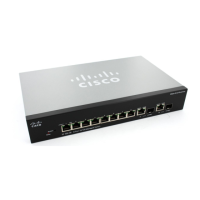Access Control
IPv6-based ACLs
Cisco Small Business 300 Series Managed Switch Administration Guide 242
17
Defining a Rule (ACE) for an IPv6-based ACL
STEP 1 Click Access Control > IPv6 Based ACE. The IPv6 Based ACE Page opens.
This window displays the ACE (rules) for a specified ACL (group of rules).
STEP 2 Select an ACL, and click Go. All currently-defined IP ACEs for the selected ACL are
displayed.
STEP 3 Click Add. The Add IPv6 Based ACE Page opens.
STEP 4 Enter the parameters.
• ACL Name—Displays the name of the ACL to which an ACE is being added.
• Priority—Enter the priority. ACEs with higher priority are processed first.
• Action—Select the action assigned to the packet matching the ACE. The
options are as follows:
- Permit—Forward packets that meet the ACE criteria.
- Deny—Drop packets that meet the ACE criteria.
- Shutdown—Drop packets that meet the ACE criteria, and disable the
port to which the packets were addressed. Ports are reactivated from the
Port Management page.
• Protocol—Select to create an ACE based on a specific protocol. Select Any
(IPv6) to accept all IP protocols. Otherwise select one of the following
protocols:
- TCP—Transmission Control Protocol. Enables two hosts to communicate
and exchange data streams. TCP guarantees packet delivery, and
guarantees that packets are transmitted and received in the order they
were sent.
- UDP—User Datagram Protocol. Transmits packets but does not
guarantee their delivery.
- ICMP—Matches packets to the Internet Control Message Protocol
(ICMP).
• Protocol ID to Match—Enter the ID of the protocol to be matched.
• Source IP Address—Select Any if all source address are acceptable or
User defined to enter a source address or range of source addresses.

